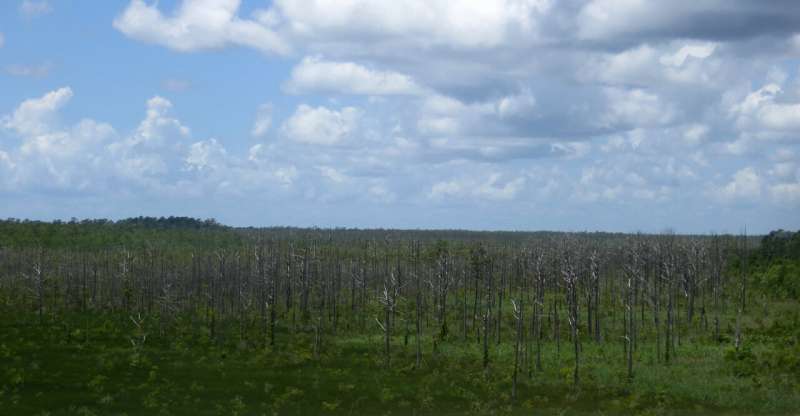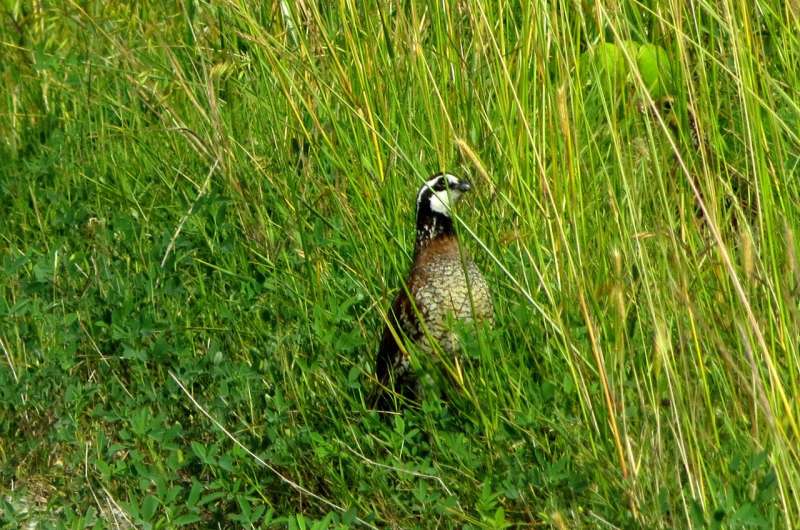How sea level rise affects birds in coastal forests

When saltwater inundates coastal forests as sea levels rise, it kills salt-sensitive trees, leaving "ghost forests" of bare snags behind. A new study from North Carolina State University explores how changes in vegetation affect coastal bird species.
Over the next century, a projected rise in sea levels will lead to chronic inundation and saltwater exposure in coastal forests around the world. When saltwater kills standing trees, forests are replaced by more salt-tolerant shrubs and grasses, which shifts vegetation closer to the ground and creates habitat for birds that prefer the understory rather than the forest canopy.
Researchers studied these changes in coastal forests on the Albemarle-Pamlico Peninsula, home to North America's second-largest estuary, where freshwater from rivers meets the ocean.
A low-lying area with thousands of square miles below 2 meters in elevation, the peninsula is highly sensitive to sea level rise. The largely undeveloped region is renowned for its animal abundance and biodiversity and has been compared to the Florida Everglades and the African Serengeti. Researchers identified 56 bird species there for the study.
To quantify changes in vegetation over time, such as those due to gradual sea level rise, researchers used sonar-like Light Detection and Ranging (LiDAR) images of coastal forests. Once they established the relationships between different bird species and the LiDAR values in present-day forests, researchers compared two sets of LiDAR data, one from 2001 and another from 2014, to determine habitat gains and losses over the 13-year period.
"We modeled the birds' relationships to the vegetation structure—forests, ghost forests and marshes—and then extrapolated to find out how much habitat was lost or gained for a given species," says Paul Taillie, lead author of an article in PLOS ONE and an NC State doctoral student when the research was conducted. "Some birds responded positively to the formation of ghost forests, including some species of high conservation value."

For example, ghost forest is a good fit for the well-known northern bobwhite quail, which has been doing poorly across most of its range, Taillie says. Birds like woodpeckers that nest in tree cavities also fared well with the changes in vegetation, including the increase in standing dead trees.
Other species that live in closed-canopy forests not affected by saltwater intrusion, such as the hooded warbler, lost habitat when ghost forests formed. Overall, ghost forests supported a different group of bird species than the forests they replaced.
To gain perspective on how birds respond to another common habitat disturbance, researchers looked at the impact of wildfires, which can kill tree canopies and change vegetation as part of the long-term process of forest regeneration.
"Habitat losses and gains associated with rising sea levels were small in scale compared to those resulting from wildfire," says co-author Chris Moorman, NC State professor and coordinator of the Fisheries, Wildlife and Conservation Biology Program. "However, changes due to sea level are likely more permanent and may compound over time."
Of course, both wildfires and sea level rise can occur simultaneously, showing the complexity of coastal forests. Researchers documented the changes in vegetation taking place in coastal forests in a recent article for Ecosystems. As trees die off, former forests become dominated by shrubs and herbaceous plants. Marshes encroach, moving inland on the peninsula without roads and buildings to block their progress. Taillie and Moorman examined marsh bird occupancy of these newly formed marshes in recent research published in Ecosphere.
"The larger story of our recent research is that this transition from forest to marshes is a kind of artifact of climate change that could actually benefit some bird species of concern for conservation, including birds associated with marshes," Taillie says. "Understanding this relationship between climate-change induced vegetation changes and birds is important because it allows us to make more informed decisions, given that these changes are going to happen within our lifetime."
The article, "Bird Community Shifts Associated with Saltwater Exposure in Coastal Forests at the Leading Edge of Rising Sea Level," appears in PLOS ONE.
More information: "Bird Community Shifts Associated with Saltwater Exposure in Coastal Forests at the Leading Edge of Rising Sea Level" PLOS ONE (2019). DOI: 10.1371/journal.pone.0216540
Journal information: PLoS ONE , Ecosystems , Ecosphere
Provided by North Carolina State University



















